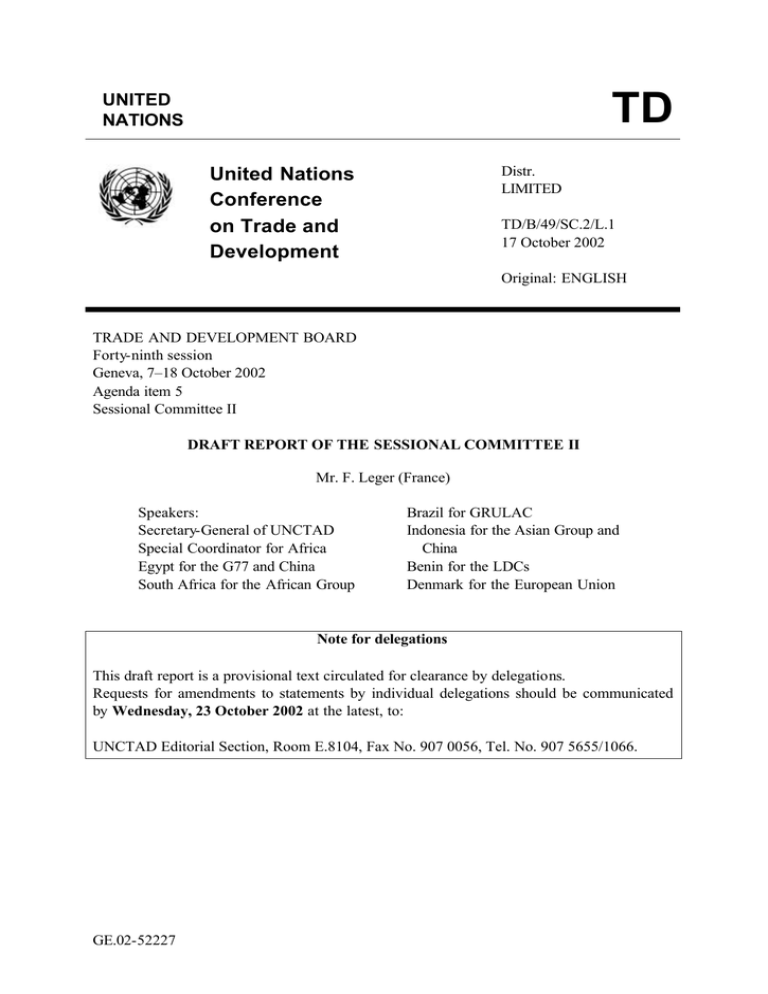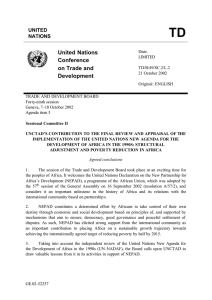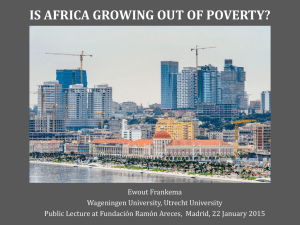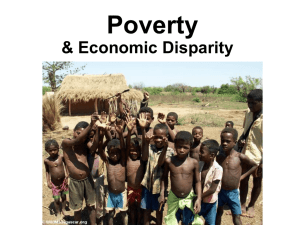TD United Nations Conference
advertisement

TD UNITED NATIONS Distr. LIMITED United Nations Conference on Trade and Development TD/B/49/SC.2/L.1 17 October 2002 Original: ENGLISH TRADE AND DEVELOPMENT BOARD Forty-ninth session Geneva, 7–18 October 2002 Agenda item 5 Sessional Committee II DRAFT REPORT OF THE SESSIONAL COMMITTEE II Mr. F. Leger (France) Speakers: Secretary-General of UNCTAD Special Coordinator for Africa Egypt for the G77 and China South Africa for the African Group Brazil for GRULAC Indonesia for the Asian Group and China Benin for the LDCs Denmark for the European Union Note for delegations This draft report is a provisional text circulated for clearance by delegations. Requests for amendments to statements by individual delegations should be communicated by Wednesday, 23 October 2002 at the latest, to: UNCTAD Editorial Section, Room E.8104, Fax No. 907 0056, Tel. No. 907 5655/1066. GE.02-52227 TD/B/49/SC.2/L.1 Page 2 UNCTAD’S CONTRIBUTION TO THE IMLEMENTATION OF THE UNITED NATIONS NEW AGENDA FOR THE DEVELOPMENT OF AFRICA IN THE 1990S: STRUCTURAL ADJUSTMENT AND POVERTY REDUCTION IN AFRICA (Agenda item 5) 1. The Secretary General of UNCTAD said that Africa’s real per capita incomes were still 10 per cent below the levels reached in 1980. The HIV/AIDS pandemic, which was similar to a war of mass destruction, was going on without adequate attention from the rest of the world. Inadequate resources for accumulation and growth, and adverse terms-of-trade move ments, remained major problems for Africa. African countries had been unable to attract foreign direct investment and official development assistance had fallen sharply, particularly in sub-Saharan Africa, while in many countries a debt overhang persisted. Despite welcome initiatives by the European Union and the United States in the area of trade the continent continued to face high tariff peaks, tariff escalation and various non-tariff barriers. The new emphasis by international financial institutions on poverty reduction did not imply a fundamental departure from previous policies. It should be underscored by a careful assessment of the impact of these policies on growth, income distribution and poverty, and any new policy prescription should be informed by social impact analysis. There were also concerns regarding governancerelated conditionality. The adoption of the New Partnership for Africa’s Development (NEPAD) by Africa’s political leaders signalled their preparedness to assume clear responsibility for institution building and good governance, but the international community had to deliver concrete support to the continent, as promised at Monterrey and at the G-8 Meeting in Kananaskis. There was a need for a lasting solution to the debt overhang and for increased aid, combined with a reduction by Africa’s trading partners of the remaining barriers to trade. 2. The Special Coordinator for Africa said that the international approach to policies for growth, development and poverty reduction continued to be based on liberalization and rapid and close integration into the world economy. However, it was not clear how policies emphasizing the primacy of market mechanisms could help to improve the access of the poor to productive assets. The freedom of action of developing country Governments in stabilization and structural adjustment programmes seemed to be severely constrained by conditionalities attached to multilateral lending and debt relief. The 6th Ministerial Meeting of the HIPC Finance Ministers had recently called for the design of more flexible, growth-oriented macroeconomic frameworks, focusing more on increasing growth and employment rather than on further reducing inflation. If poverty reduction strategies were to succeed, they should be based on a careful independent assessment of the effects of macroeconomic policies on growth, income distribution and poverty. Such policies, adapted to the structural problems and requirements of African economies, and the provision of greater space for agricultural, trade and industrial policy formulation, combined with a sustainable solution of the debt problem, adequate resources for investment in human and physical capital, and better access to markets, TD/B/49/SC.2/L.1 Page 3 could constitute the main elements of a new comprehensive deve lopment strategy which was required in order to place Africa on the road to growth and development. 3. The representative of Egypt, speaking on behalf of the Group of 77 and China, said that despite the great achievements of humanity, Africa was still lagging far behind in economic and social development. The development and social problems of the African continent, especially its LDCs, had been widely recognized. Recently, some countries had been suffering from drought and many more from the spread of HIV/AIDS. Extreme poverty had grown steadily in Africa’s poorest countries. Almost 65 per cent of the population were living on less than a dollar a day. The negative effects of an era of civil wars that had devastated many African countries were still hindering national development policies, and many countries were also suffering from unsustainable debt burden, lack of infrastructure and low school enrolment ratios. 4. In adopting the New Partnership for Africa’s Development (NEPAD), African leaders had recognized that Africans themselves had to play a substantive role in the development of their continent. However, the international community also had an important part to play in supporting the development process in Africa. Both the developed countries and the international organizations had a great deal of responsibility. UNCTAD had provided important assistance to Africa, and Africans showed a high level of commitment to that organization, repeatedly requesting that resources for the provision of such assistance be increased. Other organizations following a different policy approach, such as the World Bank and the International Monetary Fund, also had an important role. Considerable shifts in the economic thinking governing those institutions had taken place over the last two decades and the development aspect had begun to acquire an increasing place in their strategies. 5. The latest report by the UNCTAD secretariat on economic development in Africa was an important document, not only for Africa but also for all developing countries. The debate on the issues raised in that document would greatly benefit from the views of countries that had already entered the Poverty Reduction Strategy Paper (PRSP) implementation phase. It would also be useful to have a reaction from the World Bank and the International Monetary Fund. 6. The UNCTAD document could give the impression that it was challenging the new Poverty Reduction Strategy adopted by the Bretton Woods institutions; however, the views presented in that document should be considered within the framework of a positive debate aimed at maximizing the benefits obtained from implementing such strategies in different regions and minimizing any side effects. UNCTAD’s role as a pioneer in presenting developmental approaches to tackling the developing countries’ concerns in different areas was widely appreciated. It was normal that the conclusions of its reports, including this year’s report on economic development in Africa, met with both agreement and disagreement from the different delegations. It was important, however, that developing and developed countries, as well as the relevant international organizations, continued working to face the development challenge that was threatening not only the developing countries but also the entire planet. TD/B/49/SC.2/L.1 Page 4 7. The representative of South Africa, speaking on behalf of the African Group, said that the adoption of the Declaration on the New Partnership for Africa’s Development (NEPAD) signalled global support for Africa’s efforts to accelerate development and reduce poverty. UNCTAD had always proved a reliable partner of the African countries by providing necessary technical support and strengthening efforts for capacity building, but perhaps even more by breaking new ground in designing programmes that addressed trade efficiency and competitiveness. In the context of NEPAD, African leaders had committed themselves to social and economic development based on the principles of democracy, good governance and peaceful settlement of disputes. The peer review mechanism of NEPAD would also be helpful. 8. Structural adjustment and stabilization policies over two decades had ignored the very basic needs of the African people and led to an increase of poverty. Therefore, the Poverty Reduction Strategy Papers (PRSPs) of the Bretton Woods institutions, an important step in forging real partnerships, should play a central role in setting appropriate and integrated policy frameworks, and in ensuring country ownership of development strategies. The design and implementation of PRSPs involved enormous resources, and their success depended on the alignment of policies, practices and procedures by both international institutions and donors. They also required solid institutional foundations and had to be linked appropriately to national budgetary processes. In March 2002, the HIPC Finance Ministers had expressed the need to further streamline conditionality in the lending policies of the Bretton Woods institutions. It was necessary to ensure appropriate coordination of the national and the international approaches, and it was important that the policies agreed reflected the values of a modern society. 9. Poverty reduction was a function of economic growth, which in turn would be possible only in the context of flexible and growth-oriented macroeconomic frameworks that did not overemphasize anti- inflation policies but focused more on anti-poverty social spending, and particularly on education and health care. 10. The present debt overhang of African countries remained a cause of major concern since the HIPC Initiative had delivered less than satisfactory results. More innovative mechanisms beyond the HIPC had to be developed in order to enable HIPCs that reached completion point to implement long-term development strategies to promote productivity growth, human resource development and a viable enterprise base. 11. The implementation of NEPAD required constant reappraisal of programmes and policies in a very dynamic global environment. In this light, the UNCTAD report on Africa was an important contribution to the debate on poverty reduction, demonstrating UNCTAD’s comparative advantage in policy analysis. 12. The representative of Brazil, speaking on behalf of the Group of Latin American and Caribbean countries (GRULAC), said that the serious and persistent economic and social problems faced by African countries, in particular those in subSaharan Africa, required vigorous measures by the international community. Poverty reduction was of particular relevance in Africa and required a common endeavour by all TD/B/49/SC.2/L.1 Page 5 countries. It was important to help African countries to reduce the vulnerability of their economies, to internalize the process of development and to strengthen self-reliance. After two decades of policy reforms, progress in mitigating the suffering of the people of Africa and improving their economic and social indicators had been very limited, despite some positive signs that had emerged from the international community, in particular from the industrialized countries. The international financial institutions’ revision of their past approach to stabilization and structural adjustment gave rise to optimism. Since the question of poverty could not be dissociated from the globalization process, a solution could not be expected exclusively from a country’s individual efforts. The Poverty Reduction and Growth Facility (PRGF) and the Poverty Reduction Strategy Papers (PRSPs), as an integral part of the HIPC Initiative and a precondition for Poverty Reduction Support Credit (PRSC), had the potential to create some of the conditions for sustained growth, but needed to be enhanced. It was also necessary to ensure country ownership of the programmes and recognition of the policy aspirations of the poor. 13. Recent trade initiatives by the European Union and the United States were important steps forward, but there was still scope for the industrialized countries to demonstrate their commitment to help the African people, especially in the context of the Doha Ministerial Meeting, by eliminating protectionism in agriculture and textiles, and by finding an adequate solution to implementation issues, including questions related to special and differential treatment. 14. Concerted action by all stakeholders, at both the micro and macro levels, in an integrated and synergetic way was necessary for the promotion of structural adjustment in the context of globalization. For the efforts of individual countries aimed at achieving their development goals to succeed, they had to have a stable and development- friendly international financial and economic environment. Policy advice espoused under the “Washington Consensus”, including also the notion of good governance, had to be accompanied by an international setting that would guarantee financial stability, growing and predictable flows of capital, market access for products of primary export interest to African countries, provision of official development assistance in line with internationally agreed targets, and strengthening of international cooperation. 15. The international community was facing a huge challenge as 1.2 billion people were living on less than a dollar per day. The results of the HIPC Initiative had been disappointing, and a fresh and bolder approach was needed in order to remove the debt overhang of the world’s poorest countries, including an independent reassessment of debt sustainability and a moratorium on debt service payments. 16. GRULAC supported the conclusion of the secretariat’s report on economic development in Africa. Several GRULAC countries were facing economic and social problems similar to those of the African countries, such as external debt pressure, falling prices for agricultural commodities, low domestic savings and insufficient investment flows. The most effective key to the solution of the proble ms faced by the developing countries might be in the area of trade. Industrialized countries should take seriously the TD/B/49/SC.2/L.1 Page 6 need to abolish protectionism, give meaning to their free trade convictions, and help build a fair and balanced multilateral trading system. 17. The representative of Indonesia, speaking on behalf of the Asian Group and China, said that the secretariat had provided excellent documentation that facilitated the deliberations. It showed that African countries continued to be confronted with the severe problem of poverty while at the same time facing the complex challenge of globalization and liberalization of trade and finance. 18. Slow and erratic growth was a major feature of African economies. Also, there had been regressive changes in income distribution, and both sluggish growth and a deterioration in income distribution had contributed to increasing poverty in Africa. Structural adjustment policies might temporarily have an adverse impact on the poor, which could become more permanent in the absence of proper safety nets. Social impact analysis of macroeconomic and structural reform measures was needed and, where necessary, policies should be adjusted accordingly. Flexibility and adequate space for policy- making were of critical importance for African countries. Participation and ownership in the Poverty Reduction Strategy Paper (PRSP) approach should be directed towards achieving greater autonomy for the African countries in the design of their own development policies, commensurate with their needs. While poverty alleviation required appropriate social policies, rapid and broad-based growth was indispensable. The solution to poverty could not lie solely, or even primarily, in redistributional policies, not only because of the well-known political and social difficulties involved in redistribution without growth, but also because of the impossibility of making much of a dent in poverty through redistribution at a very low level of income. The design of a strategy to combine growth with redistribution should be the responsibility of the African countries themselves; policy prescriptions from outside and conditionality were not the solution. The African continent had seen the most intense and recurrent application of structural adjustment programmes over the past two decades without much progress being made in either poverty alleviation or development. For poverty reduction strategies to be successful, they had to be founded on a careful and frank independent assessment of the effects of macroeconomic and structural adjustment policies on growth, distribution and poverty. 19. The support of the international community was also critical, as were the commitments by African leaders to do their utmost to pursue development as stipulated in the New Partnership for African Development (NEPAD). The latter provided a sound framework for the international community to assist African countries, since it encompassed an integrated sustainable development initiative and ensured improved ownership of reforms by the African countries. International development cooperation had to be strengthened and to be geared towards efforts to solve the serious problems related to protectionism, reduced aid and the debt burden. An enabling international environment of trade and finance was critical for the success of NEPAD. In order to increase the probability of attaining poverty reduction goals in Africa, as reaffirmed at the Millennium Summit, it was necessary for both national authorities and the international community to discharge the ir respective responsibilities. Greater domestic policy effort TD/B/49/SC.2/L.1 Page 7 and good governance could not make up for inadequate external financing and increasing protectionism in other parts of the world. 20. The representative of Benin, speaking on behalf of the Least Developed Countries, said that beginning in the 1980s many African countries had initiated structural adjustment programmes in cooperation with the Bretton Woods institutions, with the aim of liberalizing the economy, gaining control over public spending, promoting economic growth and providing incentives for investment. The experience differed from country to country, but there were similarities. The structural weaknesses and economic constraints in the African countries had not been overcome. Moreover, poverty remained a major concern and in most countries weak and erratic growth had been accompanied by a deterioration of income distribution. In Africa about 291 million people were living below the poverty line of a dollar a day. This figure represented about 46 per cent of the world population which was facing a situation of extreme poverty. Despite efforts by Governments to improve the situation, social conditions remained precarious. There were important resource needs in order to improve the situation in many areas, such as health care, education, sustained food supply and means of communication. The Structural Adjustment Facility (SAF), the Enhanced Structural Adjustment Facility (ESAF) and the new Poverty Reduction Strategy Paper (PRSP) framework provided options for the fight against poverty, which continued to be the principal challenge. Economic reforms aimed at sustained and rapid economic growth had to be accompanied by security systems designed at the national level. It was also necessary to recognize that the economic and social situation in African countries was strongly influenced by external factors. Barriers to African access to world markets; low commodity prices; insufficient capital inflows, particularly in the form of foreign direct investment; decreasing official development assistance; and the public debt burden were constraints on the development of Africa. Of the 49 LDCs, 34 were in Africa. Therefore, the international community should support Africa more effectively in its development efforts. 21. The Group of the LDCs called upon their bilateral and multilateral partners in trade and development to take concrete action to honour their commitments under the Monterrey Consensus and the Brussels Programme of Action in Favour of LDCs, as well as the Action Plan of the G-8 summit adopted in Kananaskis in June 2002 in favour of Africa, and to support the implementation of NEPAD. 22. The representative of Denmark, speaking on behalf of the European Union and the countries seeking accession to the European Union (Bulgaria, Czech Republic, Estonia, Hungary, Latvia, Lithuania, Poland, Romania, Slovakia and Slovenia, as well as Cyprus, Malta and Turkey), said that the promotion of sustainable development in Africa was a top priority for the EU and its member States. The leadership shown by African leaders in establishing the African Union and by agreeing to the New Partnership for Africa's Development (NEPAD) was a major step towards achieving sustainable development in African countries and a reduction of poverty. NEPAD linked the need for creating conducive conditions for development to the possibilities for poverty reduction, economic development and an expansion of trade. Strengthening regional economic TD/B/49/SC.2/L.1 Page 8 communities, improving the macroeconomic framework and deeper integration, as well as improving regional trade by eliminating barriers to intraregional trade, were among the priorities established in the NEPAD plan of action. Regional integration and trade were also priorities of EU development policy and were at the heart of the ACP-EU Economic Partnership Agreements (EPAs). The EU was committed to ensuring that EPAs would contribute to achieving the main objectives of NEPAD and the African Union. 23. Increased trade flows were a precondition for the promotion of rapid growth, as were good governance and domestic policy reforms. The international financial institutions should play a supportive role. While the conditionality attached to their financial support was indispensable, it had to be considered carefully, and there was a need to focus further on a more coherent approach by all actors, including the financial institutions and organizations promoting international trade. 24. There was also a need to increase the overall level of financing for international development cooperation. In the context of the International Conference on Financing for Development, held in Monterrey, the EU had reaffirmed its commitment to reaching the 0.7 target for official development assistance (ODA). As a first significant step it had decided to increase its ODA over the next four years so as to reach collectively an EU average of 0.39 per cent. Although the HIPC Initiative would reduce the debt of 22 African countries that had followed sound economic policies and good governance, the EU was ready to consider additional debt relief for countries affected by extraordinary circumstances. _______








